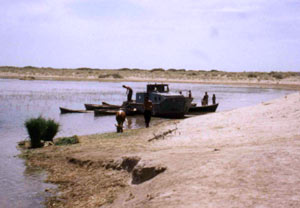 |
 |
 |
|
|||

Sea of Troubles By Rachel Dornhelm, 5/31/2002 The eeriest part of Muynaq is the sound. If you close your eyes on the old sea cliff, and listen to the wind whipping sand over the brush, it sounds just like waves breaking over a shore. It's like phantom pain -- when amputees feel sensation in missing limbs. It's the beautiful sound of what's gone...and not ever coming back. One look around Muynaq tells you that -- salt flats in place of marsh-lands, rusted-out fishing boats beached 100 miles from the shore. And as Muynaq's apartments are condemned, and the infrastructure falls apart, residents are building shantytowns with these bone-dry hulls. Faded boat names run at angles where address numbers would usually be. The first time I made the trip to the former shore, I was living in the region, doing research for grad school. I'd been curious to go to Muynaq since arriving, but none of my local friends would take me. They laughed and called it "their water museum." All I knew to expect of the trip is that it would be hot. The drying of the land, the rapid climate change -- people say they can actually feel it getting hotter day by day. To them, "How's the weather?" is a morbid joke. Finally, Simon, an Expat, offered to take me. Simon was also part of a morbid joke -- he worked for a company that struck a deal with the World Bank to "donate" farm equipment to Uzbekistan. Simon was in charge of the impeccable maintenance the company had also promised. But, there's no water here. Nobody needs a tractor. People do need cars, though. So, around Muynaq, "Case Tractor" stands in for Cadillac, and Simon's the busiest person in an otherwise lethargic region. One day, when Simon had a maintenance call near the old seashore, he invited me along. We bumped down the road in his jeep, surrounded by thermoses of hot tea and gas cans of Iranian black market fuel. We passed a camel bazaar, countless World War II monuments, and fields crusted in white salt. And every time we barreled past one of his company's red tractors, Simon stuck his head out the window and shouted, "Aaa-looh." When we got to Muynaq, Simon drove straight to the old sea cliff overlooking a view of sculpted yellow sand and tumbleweed. I wasn't sure if I wanted to know how it got that way because I was afraid it wouldn't be so beautiful to me anymore. But Simon laid out a towel, stripped down to a blue speedo and, sunning himself, launched into the story of the sea. It turns out, just after taking power, the Soviets had two big problems: not just feeding their population, but clothing them too. So, the early leadership turned to Uzbekistan, the warmest, most southern region of the new country. Fully aware of the consequences, they drew up a 5-year plan to gouge irrigation canals and flood the desert -- turn it into a cotton plantation. A really eerie monument to the plan is this mural map painted in an old Soviet ministry building. With color-coded dashed lines and arrows, it details how two east Asian rivers flowing up to Siberia were to be redirected to fill the Aral, once the sea began disappearing. But this second part of the plan was never fulfilled, and by the 70s, the tide in Muynaq was only going out. Still, the people believed the government's promises to refill the Aral. Think about it: Who would want to drain a sea? Only, instead of water, the supreme Soviet began bringing train cars of fish from the Caspian -- enough to keep the canneries going. But then the tin for the cans ran out, and then the Soviet Union dissolved, and then the people realized that the government wasn't coming back at all. And the water wasn't coming back either. Simon finished the story and wrapped a T-shirt around his head, turban style. The sun was hot. It was 3 o'clock in the afternoon, and over 125 degrees fahrenheit. I looked out again. When people referred to some place as the "ends of the earth," it usually annoys me. It seems disrespectful. But here, in the impossibly salty wind, I really did feel like I'd traveled about as far as anyone can go. Far below that sea cliff we stood on, there's a blue pond of water the locals dammed up before the sea withdrew. At the edge of the water, among the tall reeds, is a corroding old fishing trawler. Young boys hang out there, dangling rods from high up on the boat, bobbers listing -- stagnant. Through it all, here's this boat, still on track, still a fishing boat, even though the only thing keeping it afloat is the kids' imagination and the persistent phantom-waves crashing in their ears.
|
|
Search
Savvy Traveler
|
|